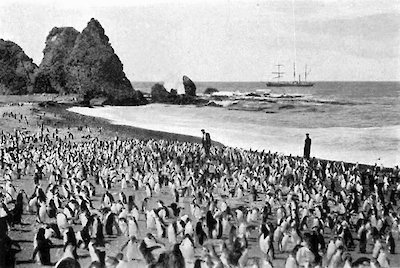Studying the natives
In their own words
[By mid-January 1912] Hamilton had visited nearly all the penguin rookeries in the vicinity, and already had several fine specimens. Marine collecting occupied part of his time and plant life promised to provide an interesting field …
During the third week of July a very low tide exposed rocks, ordinarily submerged, and Hamilton was occupied all the week in collecting marine organisms, worms and plants and then preserving, bottling and labelling them …
Hamilton returned from Sandy Bay on the 17th [November] and immediately set about collecting shags' eggs. He visited Aerial Cove for the purpose but did not get enough, and was compelled to go to West Point, where he gathered 24 dozen for specimens. He now had a collection of eggs of all birds which nest on the island, with the exception of the weka and the tern.
— George Ainsworth in The Home of the Blizzard
Mawson’s interest in sub-Antarctic biology was, as always, part of a bigger picture, and as always it had a strong connection with his central love, geology. He saw Macquarie Island’s position midway between Australia and Antarctica as crucial to understanding the evolution not only of life forms but also of landforms. In particular, he hoped that Macquarie Island’s animals and plants would give insight into the connections between the southern land masses that fossil studies had strongly suggested.
Harold Hamilton, a young zoologist from Wellington, New Zealand, had primary responsibility for collecting biological specimens and data. He was often accompanied and assisted in the field by Blake. Like Blake, he worked the length and breadth of the island, interrupting his field collecting and observing only to help Blake with his surveying and geological work.
Counting was a big part of Hamilton’s work, prompted in large part by the depredations of hunters for oil, killing first the island’s seals and then turning to penguins. He estimated 25,000 elephant seals across the island during the 1913 breeding season — a figure low by more recent standards but high enough for him to speculate that ‘it is impossible to think that the sea-elephant will ever be exterminated by human agency on Macquarie Island’. Hamilton and Blake saw numerous leopard seals ashore, as well as three Antarctic strays (two crabeater and one Weddell seal). But fur seals, the main target of the hunters, were entirely absent.
Ainsworth calculated that during the AAE’s time on the island, penguins increased their numbers by more than the total slaughter (about 150,000 birds). Royal penguins were numerous — Blake estimated there were 500,000 birds in the colony at the Nuggets — but the larger and more sought-after king penguin, Ainsworth reckoned, needed protection, reporting only 6000 on the whole island.

